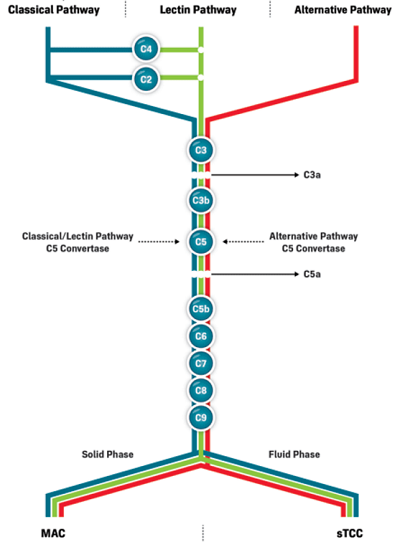Exploring the Complement System: How does it work?
Jun 30th 2020

An overview
The complement system is part of the intricate immune surveillance system to discriminate among healthy host tissue, dead cells and foreign intruders.
The immune system is traditionally divided into two parts, the innate immune system and the adaptive immune system. The adaptive immune system is one of the key elements in the development of specific antibodies to specific targets. The innate immune system, which complement is part of, on the other side reacts in a generic way to patterns of pathogen- or damage-associated molecules.
A complex hub like network
Complement was originally described in the late nineteenth century and the word complement was coined by the famous German physician Paul Ehrlich in his general theory of immunity. Today we know that the proteins of complement both act on its own and as a “complement” to the antibodies and immune cells in our host defense system.
The complement system is a complex hub like network of proteins, reactions and processes. More than 50 proteins, fluid-phased, cell-surface associated and intra-cellular proteins functions together to maintain immunosurveillance and homeostasis of our body.
The complement system is described as a double-edged sword. If not properly controlled and regulated, the complement system has the potential to harm the host. Therefore, complement activation is precisely modulated in a very specific manner and under control by many regulatory proteins.
Depending on the nature of the activating surface, complement activators initiate the classical (CP), lectin (LP) or alternative (AP) pathways.
The offensive - defensive balance of the Complement system
An intact complement system is required for host defense and healthy tissue. However, the system it does not always act as our friend. Improper, enhanced, or uncontrolled activation causes major injury and serious illness.
Disturbances in the complement system is an effector in a large variety of disorders. Autoimmune diseases, septic shock, rejection of transplants and adverse reactions against drugs and biomaterials are just a few of all conditions where complement is part of the disease process.
The question is: In how many diseases is the complement system NOT involved in the pathogenesis in some way or another?
Seeing the complete picture of Complement Function
Our complement portfolio provides easy and objective solutions in the field of complement-directed drug discovery and development.
The possibility of assessment of activity of individual pathways or total complement system activity ensures a complete picture of the complement function and answers to the new focus on complement-targeted therapeutics aiming at shifting complement back into balance.
Learn more about Complement function and activity marker assays














